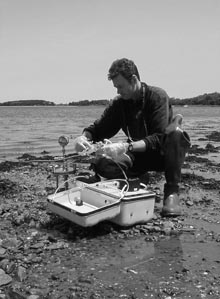
|
When
is Plastic Good for the Environment?
When Phil Gschwend exclaims "plastics!" it's hard not to think of the career advice given to Dustin Hoffman's character in The
Graduate. But with Gschwend, a professor in MIT's Department of Civil and Environmental Engineering, the enthusiasm for the material isn't about financial profit, but rather an increased understanding of chemicals in the environment.
In a current project funded in part by MIT Sea Grant, Gschwend is using plastic to collect data on levels of organic chemicals such as polyaromatic hydrocarbons (PAHs), PCBs, and dioxins in Boston Harbor waters and sediments. That data can then be used in making decisions about what areas pose risks to the animals that live there‚or the humans who eat them‚and thus should be targeted for cleanup efforts.
The traditional method for measuring chemicals in sediments and waters is to
look at chemical levels in animals such as clams and mussels, also known as
active samplers. The problem encountered with that method, says Gschwend, is
that the chemical levels accumulated by the animals did not correspond to the
researchers' models. This discrepancy means that scientists did not understand
the connection between the state of the environment and the health of organisms
living there.
"The problem we weren't solving very well was what the [chemical levels in the] water would be at equilibrium with the mud," explains Gschwend. In part, says the researcher, that mismatch was due to the presence of soots and chars. Collectively referred to as black carbons, these solids are derived from burning fossil fuels and biomass such as wood; they include diesel soot from buses, carbon from charbroiling steaks, and cinders from forest fires. Black carbons get carried by wind or washed out by rainwater, and end up in places like Boston Harbor. There, says Gschwend, those carbons mix with the mud and grab hold of many organic chemical pollutants, thereby decreasing their bioavailability. When that happens, explains Gschwend, "the water that would equilibrate would have lower concentrations than you would have expected, and that was very similar to what we saw." AmyMarie Accardi-Dey, a joint MIT/WHOI Ph.D. student, discovered that predictions of chemical levels were in fact off by a factor of 40 due to soots and chars latching on to pyrene and driving down the amount of chemicals relative to what was expected. By taking black carbons into effect, researchers are better able to make their modeling calculations fit with what they measure in the world. And they are better able to understand that chemicals of concern may be less available to move out of muds or water and into a clam or fish. But what about those plastics? Well, since passive animal samplers such as mussels are iffy indicators of what's around them in mud and water, various researchers decided to put out a material that would absorb the chemical of interest. Gschwend describes the first material chosen as "little bags of fat," that is, plastic bags filled with the triglyceride triolein. Rachel Adams, a Ph.D. student in MIT's Dept. of Civil and Environmental Engineering, tried them, but found that the bags often broke and lost the triolein. "We realized that the bag of fat was doing two things at the same time: it was accumulating the molecules in the fat inside the bag, and it was accumulating it in the plastic of the bag itself," notes Gschwend. The researchers also realized that they didn't need the triolein at all, but could rely on the plastic, polyethylene, to "do its thing." That plastic, points out Gschwend, is cheap, strong, easy to clean, and can be placed in air or water or mud for a short time to collect molecules of interest. "Anybody who's ever had milk go rancid in a plastic milk bottle knows you can't rinse out the plastic," he says. "It's going to stink for a long time because the smelly compounds have diffused into it." Working in Quincy and Dorchester Bay, Gschwend and colleagues insert plastic strips into the mud and water column to accumulate chemicals. Back in the lab, the retrieved strips are rinsed with organic solvents to recover the accumulated chemicals. The solvents are evaporated, and a small bit of concentrated extract is run on a gas chromatograph-mass spectrometer. That separates the components of the mixture and allows researchers to both identify and quantify the chemicals. Gschwend and colleagues have progressed from leaving strips in the field for a month to now leaving them for a day or two. "The dream situation," he muses, "would be to go out there, put the plastic where you want it to be, go have a cup of coffee, come back, pick it up, and go home and measure what's in it." Thus far, Gschwend says that the amount of pollutants indicated by passive samplers is less than what would have been expected based on measures of organic chemical concentrations. "Passive sampling is reinforcing the inferences of the model calculations," he notes. Another finding in Dorchester Bay and the mouth of the Saugus River is that certain chemicals are being diffused from the mud into the water, while others appear to be moving from the overlying water into the mud. By deciphering the "active" levels of pollutants, says Gschwend, people can then know, "if you eat these kinds of clams whether you would be exposed to that much of a chemical. If you can measure something," he explains, "you can say whether or not it's a problem." And coastal managers can use those measurements to make informed decisions about what areas need to be cleaned up, what dredged materials must be disposed, and what seafood is safe to eat.
|
